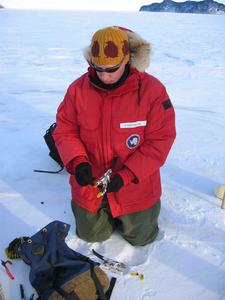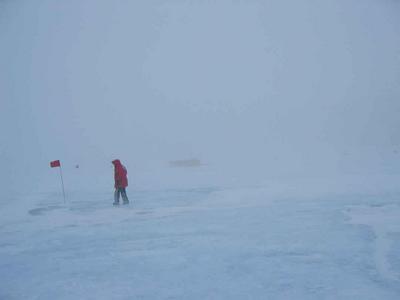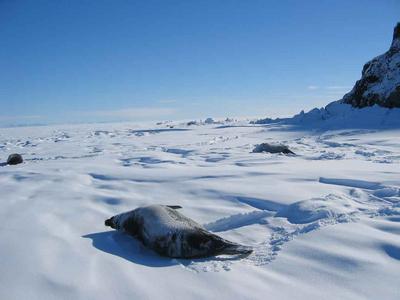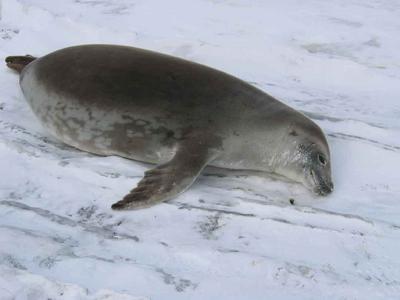29 October, 2003
Last night we had about 7-8 cm of snow in an amazingly windless
storm. We'd seen clouds building to the north all day, and they
enveloped us late in the evening. Our view of Mt. Erebus disappeared
and a light snow began to fall. By morning the storm had passed, as
silently as it had approached. The sun shone across the new snow and
it was time to set off in search of seal pups. Kelly and I went to
Tent Island, while Gillian and Mark started at Little Razorback
planning to circle around via Inaccessible Island to meet us
somewhere in the middle.
There were very few female seals and pups at Tent Island. Instead,
Tent Island seems to have become the new hangout for male seals.
Specifically, today it was the hangout for untagged male seals. This
was to be a day to practice and refine our seal-bagging skills. We
had ample opportunity to try out a variety of methods, ranging from
the simple 'toss and bag' to the 'chase and tire them out and then
bag' method. By the end of the day, our two groups had bagged and
tagged 21 males and 21 pups. As of today, we have tagged 137 pups.
This is fewer than last year's numbers, but about the same as 2 years
ago.
One note-as we were wandering amongst the Weddells there was one seal
that looked and sounded different from the others. It was a Crabeater
Seal. Even its teeth were noticeably different from the
Weddells'-their teeth have grooves on them. They are filter feeders,
sucking in seawater and straining out the krill with their teeth.
These seals usually inhabit the pack ice, but this one seems to have
found a good spot at Tent Island.
This is a good time to introduce another member of the Weddell Seal
team, Darren Ireland. When asked about his role in the project, and
life in general, Darren wrote this:
Growing up in southwest Montana I was introduced to the outdoors at
an early age. Skiing, hiking, camping, and other outdoor pursuits
have been a part of my life since I was learning to walk. Through
this exposure to the natural environment and working in Yellowstone
during summers in high school, I decided to study biology in college.
I was lucky enough to volunteer and then work for the Bear Management
Office in Yellowstone where I was first introduced to ecological
research and species management. Attempting to understand
interactions between animals, their environment, and how humans
figure into the mix was a very interesting challenge and convinced me
that I would like to continue studying ecology. At about that time
the opening for this project was announced and before I knew it I was
heading to Antarctica for my first field season.
As you may have figured out from what Susy has already written, my
part of this project involves developing a method for estimating the
mass of Weddell seals using digital photographs. The seals are very
heavy and therefore difficult to weigh without significant investment
of time and risk to the seals and researchers alike. If we can
figure out a way to accurately estimate each animal's mass from a
photograph or two, then we can obtain a much larger sample size than
previously possible with fewer disturbances to the animals. The
larger sample of individual weights from animals within the
population can provide insights into the direct effects of
environmental changes on this population of Weddell seals.
In order to build a predictive equation that will estimate an
animal's mass using measurements taken from a photograph I need to
take photographs of animals with known weights. To do this I walk
through the seal colony near our camp and take digital images from
two angles with the seals in specific body positions (laying on there
side like they usually do). In order to compare measurements between
photographs I must also hold a scale bar in the image so I can make
accurate measurements. Once the appropriate photographs have been
taken of each seal I then attempt to weigh them. This is quite an
interesting process and I believe Susy has already described it and
provided photos. When I get back to the lab I take measurements from
the photographs using special software and compare those to the
weight of the animals at time of photography, if we managed to get
the animal on the scale.
With the predictive equations (one for pups and one for adults)
finalized at the end of this season, animals will no longer need to
be weighed and all we will need to do is walk up and take a couple
photographs of a seal and we will know how much it weighs, give or
take a few kilograms.
In addition to working on his Master's Thesis, Darren has filled a
very important niche in our camp life as official 'grillmeister' in
charge of the southernmost propane grill in the world
Daily Haiku:
Adult males abound
Lounging about on the ice
Do any have tags?

Darren Ireland tagging a seal

The storm moves in from the north.

The Weddell Seals leave trails in the new snow as the move across the ice.

This is a crabeater seal. Compare it to some of the earlier pictures of Weddell Seals to see differences in coloration and the shape of its head.
Contact the TEA in the field at
.
If you cannot connect through your browser, copy the
TEA's e-mail address in the "To:" line of
your favorite e-mail package.
|
